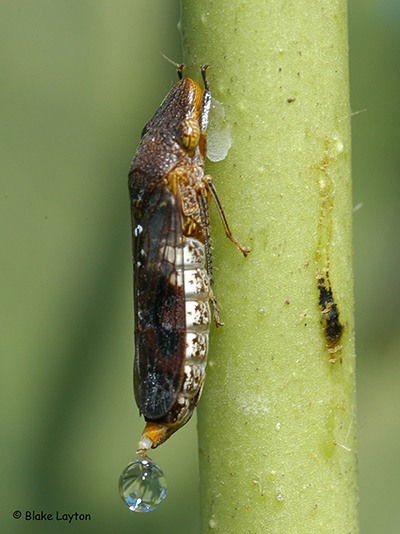Glassywinged Sharpshooter, Vol. 5, No. 13

Homalodisca vitripennis
Order: Hemiptera
Family: Cicadellidae
Ever walked under a crape myrtle tree and felt raindrops on a bright, sunny day? That’s probably not raindrops, it’s sharpshooter “dew.” Sharpshooters are large leafhoppers, up to ½ inch long, and there are several species. Like their relatives, aphids and whiteflies, sharpshooters feed by sucking plant sap. Unlike aphids and whiteflies, which feed on phloem sap, sharpshooters feed on xylem fluid, which has a much lower concentration of sugars and other nutrients. Phloem tissue transports sap that is rich in sugars and amino acids from leaves to other parts of the plant, including roots. Xylem tissue transports water and minerals from roots to the upper parts of the plant. Botany instructors often teach students to just think of dominoes. With dominoes you line ‘um up and blow ‘um down; with plants it’s—xylem up and phloem down.
As xylem feeders, sharpshooters have to consume a lot of sap to get the nutrition they need, and many sharpshooters consume, and excrete, several hundred times their body weight in liquids daily! One species was recorded to excrete as much as 430X its body volume in liquid per day. They have a highly adapted digestive system that allows them to filter out nutrients and excrete the remaining liquid.
Where does all this excess liquid go? Look out below! This is where sharpshooters get their name; they forcibly eject large droplets of liquid, sometimes referred to as ‘bug dew’. Because of its low sugar content, this liquid is not sticky like the honeydew produced by aphids and does not usually cause sooty mold. ‘Squirrelbug’ is another name sometimes used for these insects, because of their habit of scurrying to the opposite side of a plant stem when approached. Gardeners often witness this behavior on okra and sunflowers.
Despite the large amounts of fluid they remove from plants, sharpshooters usually cause no serious damage to the plants they feed on. At least not directly. However, sharpshooters vector a bacteria that causes serious disease symptoms in many plants, with symptoms varying depending on host species. In peaches, this is known as phony peach disease, in oaks and pecans it is called bacterial leaf scorch, and in grapes it causes Pierces disease. In fact, Pierce’s disease is one of the limiting factors for growing grapes in the South. Muscadines, on the other hand, are tolerant to Pierce’s disease. Unfortunately, there is little that can be done to prevent or control or prevent this disease, especially in landscape plants.
Control: Doing nothing is usually the best approach to dealing with sharpshooters. If they commonly infest crape myrtles or other small trees that provide shade over a frequently used sitting area where the ‘bug dew’ is objectionable, you can apply a preventive treatment in the spring. Look for an insecticide containing the active ingredient imidacloprid and apply as a soil drench according to label directions. This treatment also controls aphids and crape myrtle bark scale.
For detailed information on how to use and apply soil-applied systemic insecticides see the appropriate sections of Extension Publication 2938, Crape Myrtle Bark Scale Identification and Control.
Blake Layton, Extension Entomology Specialist, Mississippi State University Extension Service. The information given here is for educational purposes only. Always read and follow current label directions. Specific commercial products are mentioned as examples only and reference to specific products or trade names is made with the understanding that no discrimination is intended to other products that may also be suitable and appropriately labeled.
Sign up to receive Bug's Eye View

